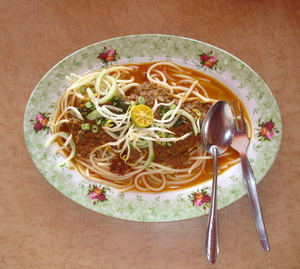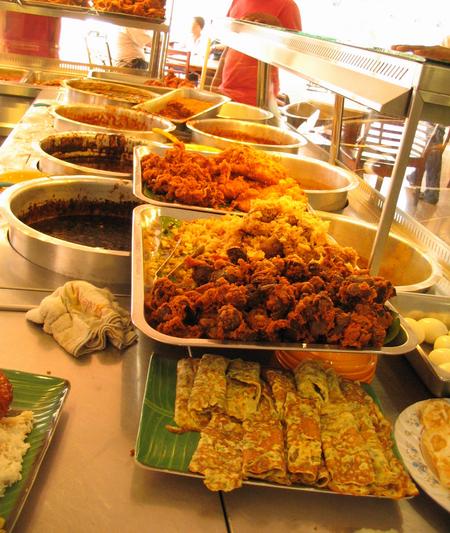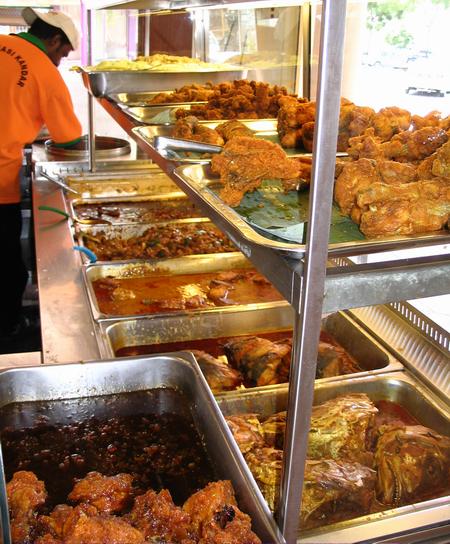



A multi-ethnic country with a multi-ethnic exotic cuisine
Food is not only a popular but an essential topic in Malaysia. Eating out in Malaysia is a gastronomic adventure. There is such a great variety; spicy Malay Food, a seemingly endless variety of Chinese food, exotic cuisine from North and South India, as well as Nyonya and Portuguese Food.
Malaysian Food reflects the multi-racial aspect of the country. The 3 cultural groups, the Malays, the Chinese and the Indian each their own style of cuisine. Malaysian food represents an exotic fusion of culinary delights- a cuisine heavily influenced by people from India, China, Indonesia and Thailand who have all settled there and have melded together tastes, ingredients and cooking methods from each other. The unique Peranakan, also known as Nyonya cuisine is a fusion of Chinese and Malay styles. As a result of all these influences, there is seemingly no limit when it comes to the variety and abundance of food you can get here.
Malaysian cuisine uses fragrant herbs and roots such as lemongrass, ginger, shallots, coriander, fennel, kaffir limes and fresh and lada kering (dried chillies), usually ground into a sambal, or chilli paste. There is usually a sprinkling of mustard seeds, star anise, cardamom and cloves in Malaysian recipes. Some lesser known ingredients include bunga kantan (wild ginger flower buds), turmeric root, galangal and pandan, or screwpine leaf.
A traditional accompaniment to meal is a hot sambal made of ground chilli, otaku dang (prawn paste) and condiments. Desserts in Malaysia tend to make use of generous amounts of coconut milk.
Local food is a mixture of many elements, and no wonder then that the name of one of the most popular dishes, rojak, is also slang for a haphazard mixture of things. Perhaps the closest thing to a national dish is nasi lemak - rice cooked in coconut milk and eaten with a range of side dishes and condiments.
There is also satay, pieces of meat skewered on thin sticks, grilled over a charcoal fire and dipped in a spicy peanuts sauce, which is certainly the most popular dish of Malaysia. Another type of meal that has crossed over from its ethnic origins (South Indian) to become a national favourite is banana leaf rice. It is simply rice that's eaten off a banana leaf with an accompaniment of meats, curries, vegetables, pickles and crispy pappadoms. Popular Malaysian dishes include rendang, roti canai, murtabak, laksa, chicken rice, and fried noodles.
Many states, many variations of the cuisine

Each state in Malaysia has something different to offer in terms of culinary delights. Kuala Lumpur has the most diverse offering of foods from all over the world. You can indulge in a choice of gourmet fusion cuisine created by talented chefs in designer restaurants, or sample an endless amount of goodies found practically bursting out of malls, store fronts and side-street hawker stalls.
Melaka is also home to delicious Baba Nyonya food, much of it served in quaint cafes in historical shophouses.
Penang is hawker stall heaven, where the most delicious food requires you to wait for al fresco tables and costs as little as RM3.50 per dish.
Ipoh receives many day trippers who come only to savour local favourites.
Kelantan is the cradle of Malay culture and serves exotic Malay food rich in flavour and colour.
Individual recipes vary widely from state to state. Basic ingredients may be the same, but the method of cooking and accompanying dishes changes with each state's own tastes and special produce. The perennial Malaysian favourite nasi lemak is completely different in Kedah, for example, than that tasted in Johor or Selangor. One has to savour both to truly appreciate the diversity of preparation.
Penang Laksa is completely different from Singapore Laksa or kari laksa: Imagine a large, steaming bowl of rice noodles with prawns and chicken and bean curd, immersed in a reddish, lemon grass-perfumed coconut curry sauce, as fiery and flavorful as a human hand can produce, topped with a mélange of raw, crunchy vegetables and herbs – bean sprouts, cucumber bits, sliced red chillies, spring onions and Vietnamese mint – served with a side of chilli sambal and lime slices. There are many regional variations of this soupy, Malaysian noodle dish. In Penang, the city’s very own tamarind-soured assam laksa, was Asia’s answer to southern France’s fish soup, a very exotic version, where, instead of the dollop of the garlicky rouille on top, the soup had been showered with a fine julienne of a pink, highly aromatic, wild ginger flower and slivers of fresh, sour pineapple.
Breakfast is a major meal of the day, not a neglected snack.
Street stalls, part of the eating culture


Excellent and inexpensive food can be obtained virtually anywhere in Malaysia, largely because of the strength and ubiquity of food stalls. Whether it be in villages, small towns, or big cities, visitors can find stalls offering mouth-watering treats. Dining at a cart or streetside stand may sound plain and piecemeal, but in Malaysia eating food at the roadside stalls is a much-loved practice. The best stalls are as popular and as crowded as any permanent restaurant - VWs and BMWs are equally likely to be parked close by, and their owners rubbing shoulders in the long line. Some stalls are open from morning to evening, while others are open from evening to dawn. Others are open around the clock, seven days a week.
A great variety of ingredients, a great variety of dishes



Malay food derives its flavours from the use of spices and local ingredients. Some of those ingredients used by the Malays in the Malay cuisine are:
Another ingredient commonly found in Malaysian food is santan which is coconut milk. The milk is squeezed from the flesh of the grated coconut. As a sign of modern times, santan can be found in powder form, sold in supermarkets. It's much used by actually in the Malay cuisine.
As with other cuisines, Malay food is prepared and enjoyed by all races. A staple breakfast favourite is nasi lemak. It is a simple but very satisfying meal. The rice is cooked in coconut milk with fragrant pandan leaves. Side dishes can be sambal ikan bilis (anchovies with chili), omelets or hard boiled eggs, peanuts, sliced cucumber, prawns and fried fish.
Another classic example of ever popular Malay food is satay. There is no pasar malam (night market) without satay. It usually consists of chunks of chicken marinated with a variety of spices.
Ikan bakar is grilled or barbecue fish which you will be able to find almost everywhere. A popular local fish is the Ikan Kembong.
Rendang is a meat dish (chicken or beef) prepared with coconut milk, lada (chillies), onion, and other ingredients. Around Pangkor and Lumut the most famous kind of rendang is rendang tok. It contains beef, coconut milk, onion, garlic, chilies, coriander powder, cumin, black pepper, fennel, turmeric root, lemon grass and other ingredients. If you visit a Malay wedding you will most likely have some rendang as it is usually used for special occasions.
The Indian influence on Malaysian food
Malaysian food from the Indian population is quite different from the Malay or Chinese cuisine. The Indians favour hot and spicy flavours. Their staple diet usually consists of either rice or bread (charpatti, tosai (thosai), parrata, puri). They eat this with various curries. As in accordance with their Hindu beliefs, they do not eat beef.
The Malaysian food of the Indian population in the North-West part of Malaysia can be categorized as Southern-Indian, Northern Indian and Indian Muslim (mamak). Along with the rest of the local cuisine, it has evolved and assimilated according to society's preferences. Sometimes what is considered Indian food here, did not even originated from India.
Usually Indian Malaysian food is sold at the various local stalls and often ordered with a glass of teh tarik. Teh Tarik literally means "pulled tea". The tea is thick and frothy. The preparation involves passing the tea and milk from one big metal mug to the other with a "pour and pull" action.
Where there is roti canai, there is bound to be murtabak. This is basically roti canai with stuffing of sardines or chicken as the Indian Hindus do not eat beef. Murtabak with beef however can be obtained from stalls owned by Muslims.
Nobody really knows how roti canai came about to become one of the most popular of Malaysian food. However, Penang can certainly lay claim to Indian mee (mee goreng or kelinga mee). From Penang, these dishes spread out further over Malaysia.
One could say the apart from nasi lemak, roti canai is probably the second national Malaysian food.
Indian mee was first created by Indian sailors and port workers. It is a combination of Chinese fried noodles with prawn fritters, potato, squid, taukua (bean curd, bean sprouts and lettuce). For more filling, an egg is usually scrambled into the mix. Mention North Indian food and what comes to mind is tandoori and naan bread. Both are cooked in clay oven called tandoori. Northern Indian food is found in air-conditioned restaurants, richly decorated to reflect the Indian culture and Hindu tradition.
The Chinese influence on Malaysian food
Since most of Malaysia's Chinese are from the south, particularly from Hainan and Hakka it is quite easy to find food from this region. Throughout Malaysia one of the most widespread economical meals is the Hainanese Chicken Rice. It's another of the local favourite Malaysian foods. The Hainanese also produced steamboat, sort of Oriental variation of the Swiss Fondue, where you have a boiling stockpot in the middle of the table into which you deep pieces of meat, seafood and vegetable.
The Hokkiens have provided us the Hokkien fried Mee (thick egg noodles cook with meat, seafood and vegetable and a rich kicap (soya sauce).If you go to North Malaysia, Hokkien Mee means prawn soup noodles. Hokkien spring rolls (popiah) are also delicious.
Teochew food from the area around Swatow in China is another style noted for its delicacy and natural favourite. Teochew food is famous for its seafood and another economical dish - Char Kwey Teow (fried flattened noodles) with clams, beansprout and prawns.
Hakka dish is also easily found in food centres. The best known hakka dish is the Yong Tau Foo (stuffed seafood bean curd) with soup or thick dark gravy.
When Westerners speak of Chinese food, they usually mean Cantonese food. It is the best known and most popular variety of Chinese food. Cantonese food is noted for the variety and the freshness of its ingredients. The food is usually stir-fried with just a touch of oil. The result is crisp and fresh. All those best known 'western Chinese' dishes fit into this category - sweet and sour dishes, won ton, chow mein, spring rolls.
With Cantonese food the more people you can muster for the meal the better, because dishes are traditionally shared so everyone will manage to sample the greatest variety. A corollary of this is that Cantonese food should be balanced: traditionally, all foods are said to be either Yin (cooling) - like vegetables, most fruits and clear soup; or Yang (heaty) - like starchy foods and meat. A cooling food should be balanced with a heaty food and too much of one would not be good for you.
Malaysians enjoy eating out to savour a variety of items at different times of the day. Enjoying a dish in the street is a big part of Malaysian culture. Malaysia offers Asia’s best variety of cuisine given the wide array of cooking styles and traditions.















































